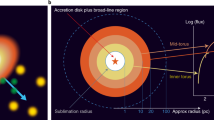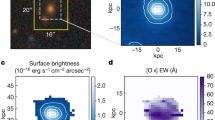Abstract
Active galaxies are characterized by prominent emission from their nuclei. In the ‘unified’ view of active galaxies, the accretion of material onto a massive compact object—now generally believed to be a black hole—provides the fundamental power source1. Obscuring material along the line of sight can account for the observed differences in the nuclear emission2,3, which determine the classification of AGN (for example, as Seyfert 1 or Seyfert 2 galaxies). Although the physical processes of accretion have been confirmed observationally4,5, the structure and extent of the obscuring material have not been determined. Here we report observations of powerful hydroxyl (OH) line emissions that trace this obscuring material within the circumnuclear environment of the galaxy Markarian 231. The hydroxyl (mega)-maser emission shows the characteristics of a rotating, dusty, molecular torus (or thick disk) located between 30 and 100 pc from the central engine. We now have a clear view of the physical conditions, the kinematics and the spatial structure of this material on intermediate size scales, confirming the main tenets of unification models.
This is a preview of subscription content, access via your institution
Access options
Subscribe to this journal
Receive 51 print issues and online access
$199.00 per year
only $3.90 per issue
Buy this article
- Purchase on Springer Link
- Instant access to full article PDF
Prices may be subject to local taxes which are calculated during checkout



Similar content being viewed by others
References
Rees, M. J. Black hole models for active galactic nuclei. Annu. Rev. Astron. Astrophys. 22, 471–506 (1984)
Krolik, J. H. & Begelman, M. C. Molecular tori in Seyfert galaxies: Feeding the monster and hiding it. Astrophys. J. 329, 702–711 (1988)
Krolik, J. H. Active Galactic Nuclei (Princeton Series in Astrophysics, Princeton Univ. Press, Princeton, New Jersey, 1999)
Greenhill, L. J. et al. Detection of a subparsec diameter disk in the nucleus of NGC 4258. Astrophys. J. 440, 619–627 (1995)
Gallimore, J. F., Baum, S. F. & O'Dea, C. P. A direct image of the obscuring disk surrounding an active galactic nucleus. Nature 388, 852–854 (1997)
Baan, W. A. Powerful extragalactic masers. Nature 315, 26–31 (1985)
Maloney, P. R. Powerful water masers in active galactic nuclei. Publ. Astron. Soc. Pacif. 19, 401–421 (2002)
Herrnstein, J. R. et al. Polarimetric observations of the masers in NGC 4258: an upper limit on the large-scale magnetic field 0.2 parsecs from the central engine. Astrophys. J. 508, 243–247 (1998)
Diamond, P. J., Lonsdale, Co. J., Lonsdale, Ca. J. & Smith, H. E. Global VLBI observations of the compact OH megamaser emission from III ZW 35 and IRAS 17208-0014. Astrophys. J. 511, 178–184 (1999)
Lonsdale, Co. J., Lonsdale, Ca. J., Diamond, P. J. & Smith, H. E. Symmetric parsec-scale OH megamaser structures in Arp 220. Astrophys. J. 507, 615–654 (1998)
Pihlström, Y. M., Conway, J. E., Booth, R. S., Diamond, P. J. & Polatidis, A. G. EVN and MERLIN observation of III Zw 35. Astron. Astrophys. 377, 377–413 (2001)
Baan, W. A. Infrared properties of OH galaxies. Astrophys. J. 338, 804–811 (1989)
Baan, W. A., Salzer, J. J. & LeWinter, D. Optical classification of megamaser galaxies. Astrophys. J. 509, 633–645 (1998)
Ulvestad, J. S. et al. Subrelativistic radio jets and parsec-scale absorption in two Seyfert galaxies. Astrophys. J. 517, L81–L84 (1999)
Ulvestad, J. S., Wrobel, J. M. & Carilli, C. L. Radio continuum evidence for outflow and absorption in the Seyfert 1 galaxy Markarian 231. Astrophys. J. 516, 127–140 (1998)
Richards, A. et al. in Galaxies and their Constituents at Highest Angular Resolutions (eds Schilizzi, R. T., Vogel, S. F. P. & Elvis, M. S.) 212–215 (IAU Symposium 205, Astronomical Society of the Pacific, San Francisco, 2001)
Taylor, G. B., Silver, C. S., Ulvestad, J. S. & Carilli, C. L. The starburst in the central kiloparsec of Markarian 231. Astrophys. J. 519, 185–190 (1999)
Bryant, P. M. & Scoville, N. Z. High-resolution CO observations of the ultraluminous infrared galaxy Markarian 231. Astrophys. J. 457, 678–692 (1996)
Downes, D. & Solomon, P. M. Rotating nuclear rings and extreme starbursts in ultraluminous galaxies. Astrophys. J. 507, 615–654 (1998)
Carilli, C. L., Wrobel, J. M. & Ulvestad, J. S. A subkiloparsec disk in Markarian 231. Astron. J. 115, 928–937 (1998)
Baan, W. A., Henkel, C. & Güsten, R. Rotationally excited OH in megamaser galaxies. Astron. Astrophys. 185, 14–24 (1987)
Randell, J., Field, D., Jones, K. N., Yates, J. A. & Gray, M. D. The OH zone in OH megamaser galaxies. Astron. Astrophys. 300, 659–674 (1995)
Baan, W. A., Wood, P. A. D. & Haschick, A. D. Broad hydroxyl emission in IC 4553. Astrophys. J. 260, L49–L52 (1982)
Keiichi, W. & Norman, C. A. Obscuring material around Seyfert nuclei with starbursts. Astrophys. J. 566, L21–L24 (2002)
v. Langevelde, H. et al. A thin circumnuclear disk in NGC 4261. Astron. Astrophys. 354, L45–L48 (2000)
Schmitt, H. R. et al. Testing the unified model with a infrared-selected sample of Seyfert galaxies. Astrophys. J. 555, 663–672 (2001)
William, J., Biretta, J. A. & Livio, M. Formation of the radio jet in M87 at 100 Schwarzschild radii from the central black hole. Nature 401, 891–892 (1999)
Acknowledgements
We thank C. Carilli for providing a map of the diffuse continuum structure in Mrk231. H.-R.K. thanks O. Möller for advice on programming in OpenGL software. The European VLBI Network is a joint facility of European, Chinese, South African and other radio astronomy institutes funded by their national research councils. The Westerbork Synthesis Radio Telescope is operated by ASTRON (Netherlands Foundation for Research in Astronomy) with support from the Netherlands Foundation for Scientific Research (NWO).
Author information
Authors and Affiliations
Corresponding author
Ethics declarations
Competing interests
The authors declare that they have no competing financial interests.
Rights and permissions
About this article
Cite this article
Klöckner, HR., Baan, W. & Garrett, M. Investigation of the obscuring circumnuclear torus in the active galaxy Mrk231. Nature 421, 821–823 (2003). https://doi.org/10.1038/nature01381
Received:
Accepted:
Issue Date:
DOI: https://doi.org/10.1038/nature01381
This article is cited by
-
Circumnuclear dense gas in OH-megamaser galaxies
Astrophysics (2010)
-
Properties of OH Megamaser Galaxies in the Radio Continuum. II. Data Analysis
Astrophysics (2005)
-
Oh Megamasers: Circumnuclear Gas in Starbursts
Astrophysics and Space Science (2005)
-
Megamasers: Molecular Diagnostics of the Nuclear Ism
Astrophysics and Space Science (2005)
Comments
By submitting a comment you agree to abide by our Terms and Community Guidelines. If you find something abusive or that does not comply with our terms or guidelines please flag it as inappropriate.



